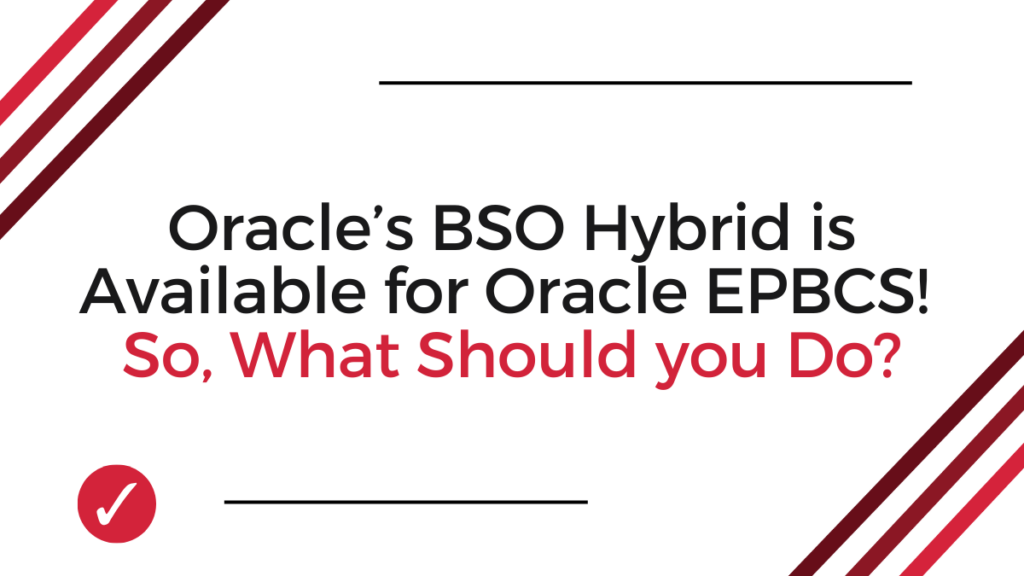
If you haven’t checked out the latest June 2019 updates for Oracle Cloud you may have missed the big announcement of PBCS and EPBCS using Hybrid BSO. From early blogs we discussed what kind of impact Hybrid can have for you including dramatic database size reduction, instant calculations and overall performance improvement. The great thing is whether you’ve already deployed Planning (as we’re now referring to PBCS and EPBCS) or you are starting from scratch, Oracle has a deployment model for you.
Before you begin there are some things to consider and some requirements. As always, we recommend testing Hybrid in your Test environment before moving anything to Hybrid, and if it’s been a while since you’ve synchronized your Test and Production environment start with that first. Here are a few of the other considerations:
- You are licensed for EPBCS as opposed to PBCS
- Your application is a traditional monthly application as opposed to daily, weekly, quarterly or some other custom time period
- You can rename the Year dimension to Years
- If you enabled Multi-Currency, it’s the simplified version
- None of your dimensions, forms, rules, dashboards or other objects use the following prefixes:
- oep_ – for common artifacts
- ofs_, owp_, opf_ or ocx
Moving an existing application to Hybrid
So how do you get to Hybrid with your existing application? There are a few steps you need to follow.
- Complete a Refresh of your application to ensure everything is push down to the cubes
- Take a Snapshot of your application under Migrations
- Open a Support Request (SR) with Oracle to move your environment to Hybrid mode
- In the SR you have to authorize Oracle to enable Hybrid on your EPBC environment. Here’s the recommended SR Content: “I authorize Oracle to enable Hybrid mode on my EPBCS environment. I know that the environment will be recreated, and the application will be deleted, and I will have to either import the backup LCM snapshot that I have or recreate the application from scratch.”
- Support will then open this as a bug, so it receives approval from EPM Product Management for approval
- Once approved and your environment is enabled you can import the LCM backup
- Go to the Application Overview page and select from the drop down “Enable Hybrid”
- If everything works well in Test, you’ll need to go through the same process for Production
Activating the Power of Hybrid
Now that you’ve got Hybrid enabled you still have a few steps to see all the advantages. The first step, and the whole point of Hybrid is to make your sparse dimension parents dynamic. By making them dynamic you no longer have to aggregate the members or move them to a Reporting/ASO cube as part of your process so you can remove all those aggregations in Rules and Data Movements.
Other Considerations
The other things to consider is because everything is dynamic will there be any impact on calculations and reports that should be tested. Specifically, if you have any calculations that use parent members that we now are tagging as dynamic we want to make sure the speed of those calculations are working as expected. As opposed to when those parents were stored, the values we’re already calculated, now they’re being calculated on the fly.
Last, make sure to check reports to see if when you report off these parent members, because they are being calculated at the point of request it may operate differently than when it was stored. Our early testing saw little impact on this but still worth a review.
If you do see any impact on either of these, keep in mind you can take a mixed approach to Hybrid and make some dimensions dynamic and still aggregate other dimensions that are sparse. Keep testing until you’ve gone through a full cycle with the application and make sure to have the users test it as well.
For more information on how to elevate your EPM Cloud application through Oracle’s Hybrid BSO for EPBCS migration, connect with one of our EPM experts by contacting [email protected]. Stay ahead of the curve on all things Oracle Cloud by subscribing to Elire’s Monthly Cloud Newsletter or following us on LinkedIn and Twitter.
SME Author
-

Scott Costello
Mr. Costello is an experienced EPM specialist with over 20 years of experience helping organizations with their Close, Budgeting, Forecasting and Reporting needs. Certified in Oracle EPM solutions from on-premises Hyperion to the Cloud EPM suite, he has lead over 60 projects as an architect, project manager and consultant to provide clients with the best overall solution.
Author
-

Ms. Hutchcraft serves as Elire’s Marketing Associate, working to develop and optimize marketing brand assets. Jordan collaborates with the Elire Marketing Team to produce blog and social media content, strategize for social media expansion, and maintain Elire’s internal and external branding.
